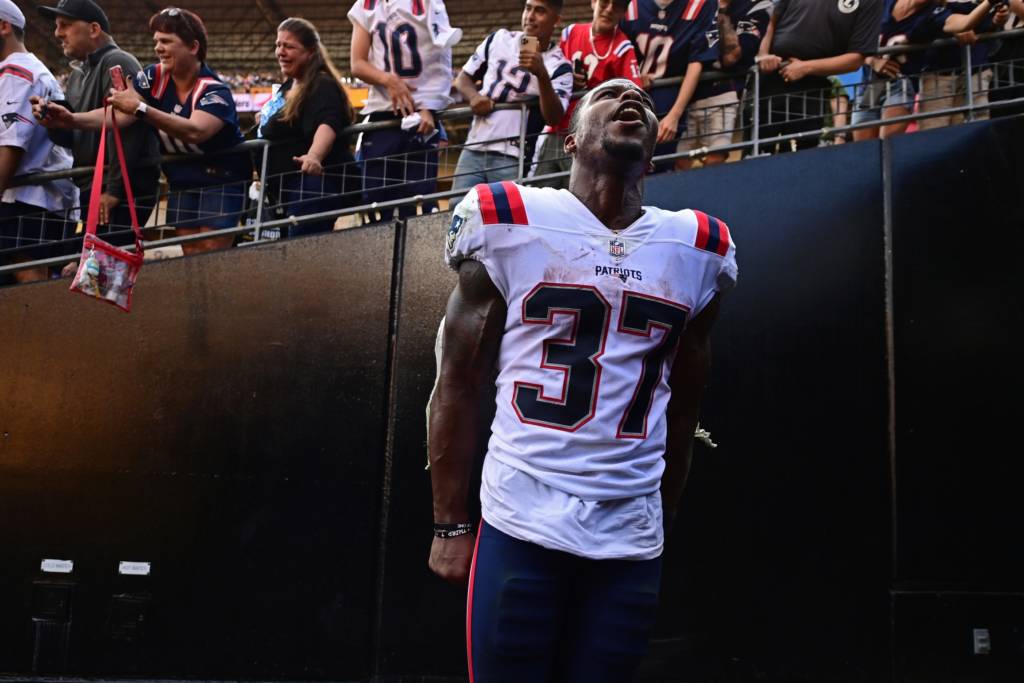The New England Patriots live in a new era of offensive football. Two years after the departure of Tom Brady in free agency, the team also lost offensive coordinator Josh McDaniels, who became the Las Vegas Raiders’ head coach. It hasn’t been an easy transition, but Bill Belichick’s mantra will not change: The Patriots will attack the opponent’s weaknesses, which will be their primary focus. That’s why New England will lean into the run game against Green Bay.
Patriots running backs Damien Harris and Rhamondre Stevenson have averaged 4.8 yards per carry this season. Even without old friend Ty Montgomery, who is supposed to be the receiving back and is injured, the Pats still have weapons.
It’s an essential part of the gameplan for two other reasons. First, starting quarterback Mac Jones suffered a high ankle sprain. He hasn’t practiced this week and is not expected to play on Sunday. Therefore, it makes sense to take the burden off veteran backup Brian Hoyer‘s shoulders. Moreover, the team is 21st in defensive DVOA, so it is important to keep Aaron Rodgers off the field as long as possible.
Even though the Patriots’ running backs have had decent numbers, there is still room for improvement along the offensive line. While the Patriots are 11th in pass-block win rate, the team is only 27th in run-block win rate (both are ESPN metrics).
In neutral situations, the Patriots have been average in pass rate, but it won’t be surprising if they change the approach for this game without Jones. Matt Patricia is the offensive play-caller. He’s also the de facto offensive line coach and run-game coordinator. The other top offensive assistant is former New York Giants head coach Joe Judge, who works as the de facto quarterbacks coach and pass-game coordinator.
Packers problems
The Packers’ defense has struggled to stop the run for a long time. However, it’s not as glaring as it was when Mike Pettine was the defensive coordinator. Green Bay is 21st in run-stop win rate, at 29%. The front is better against the pass: 16th in pass-rush win rate, at 42%. Edge defenders Rashan Gary and Preston Smith lead the NFL in combined pressures for an edge duo.
The run defense has allowed 4.9 yards per carry this season. However, the total numbers weren’t high against the Minnesota Vikings and the Tampa Bay Buccaneers. First, because the Vikings prioritized passing the ball. And second, because the Bucs have been inefficient running the ball so far with a new configuration of their offensive line.
However, the Chicago Bears were able to expose the Packers’ run defense. It was also a matter of the Packers being okay with the Bears running the ball because they were winning the game — chewing time off the clock made sense — but also it showed weaknesses that are not new. David Montgomery ran 15 times for 122 yards, an 8.1 average per rush. Backup Khalil Herbert ran only four times but still had 38 yards — 9.5 yards per rush.
Scheme difference from last year
There might be schematic differences compared to last season that help explain the numbers. Not that last year’s defense was any good against the run, but this year’s looks as bad, even with the additions of Jarran Reed and Quay Walker.
While the expectation was that the Packers would run a one-and-half gap technique as the Los Angeles Rams and Denver Broncos do, and Green Bay did last season, Joe Barry has distanced himself from that approach.
The strategy up front has been more reminiscent of what Barry learned under Rod Marinelli, with whom he worked when he was with the Buccaneers and Detroit Lions in the 2000s. It is a simple one-gap structure that prioritizes defensive linemen and edge rusher penetration and overloads the off-ball linebackers.
De’Vondre Campbell is not exactly a run specialist, and rookie Walker is still learning the pro game and adapting to his assignments.
What the Packers can do
During the first three weeks of the season, the Packers played a significant number of snaps in the nickel package. With this personnel, the Packers took Walker off the field, and slot corner Rasul Douglas was in. In some situations, Douglas essentially played as an off-ball linebacker, a role that was filled by a third safety last season, usually Henry Black.
That formation is efficient against the pass, but it’s hard to stop the run with fewer players up front. And the Packers used it not only against lighter offensive groupings but also against 12 and 21 personnel.
With Jaire Alexander questionable for the game — he sustained a groin injury against the Bucs and didn’t practice on Thursday — Douglas might play most of the game as a boundary cornerback. Keisean Nixon performed well in Tampa as the slot corner, but he is not nearly as physical as Douglas, so Barry probably won’t use him in the box.
As the Patriots use a heavy dose of personnel with two running backs or two tight ends, the Packers should be in base for most of the time.
The Packers are better than the Patriots, according to Football Outsiders’ DVOA — and most metrics. They are favored to win, especially if the Patriots are forced to play their backup quarterback. But showing they can stop the run is an important step toward building a complete team, and Sunday is an excellent opportunity for Green Bay to do it.

